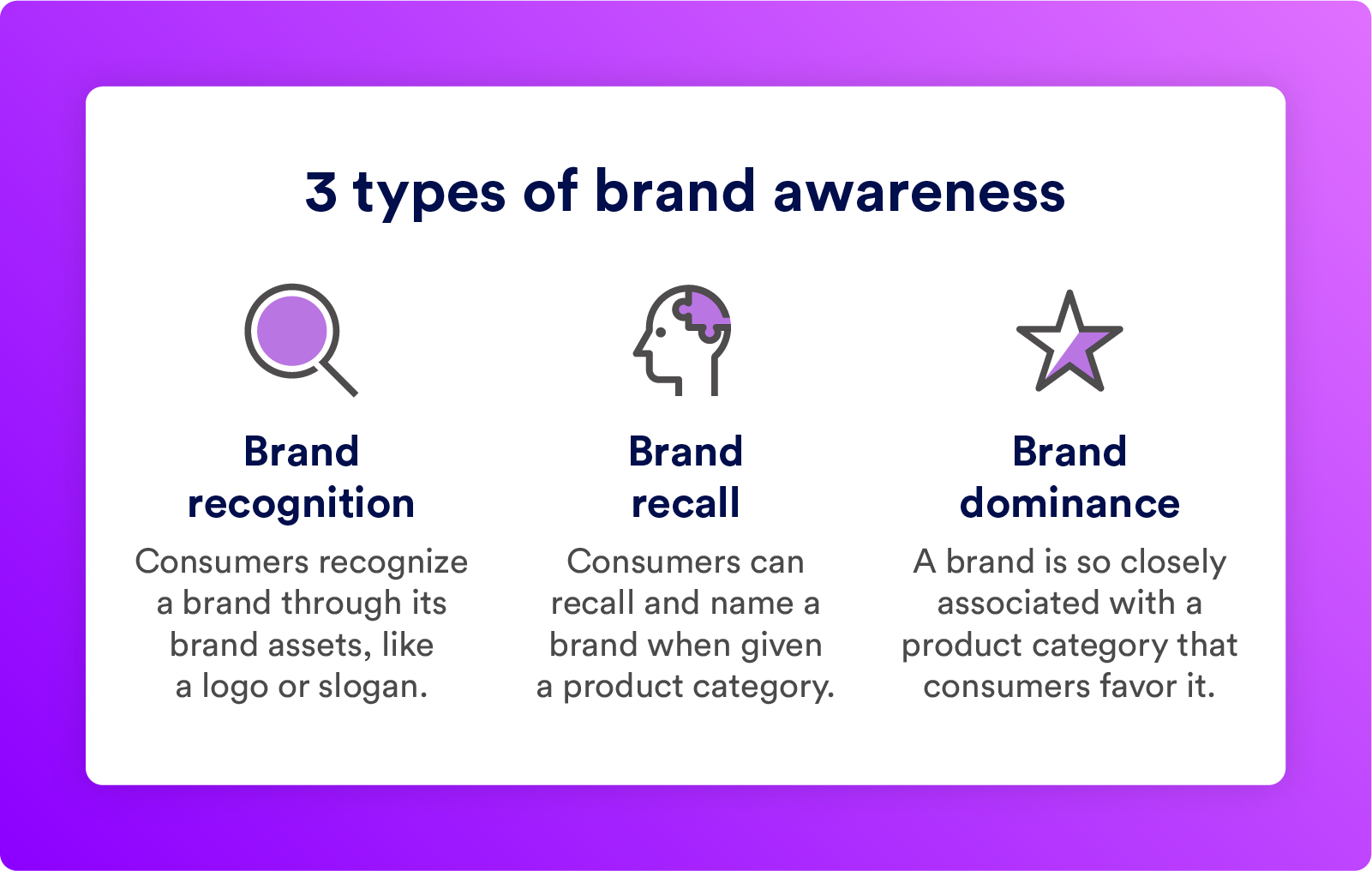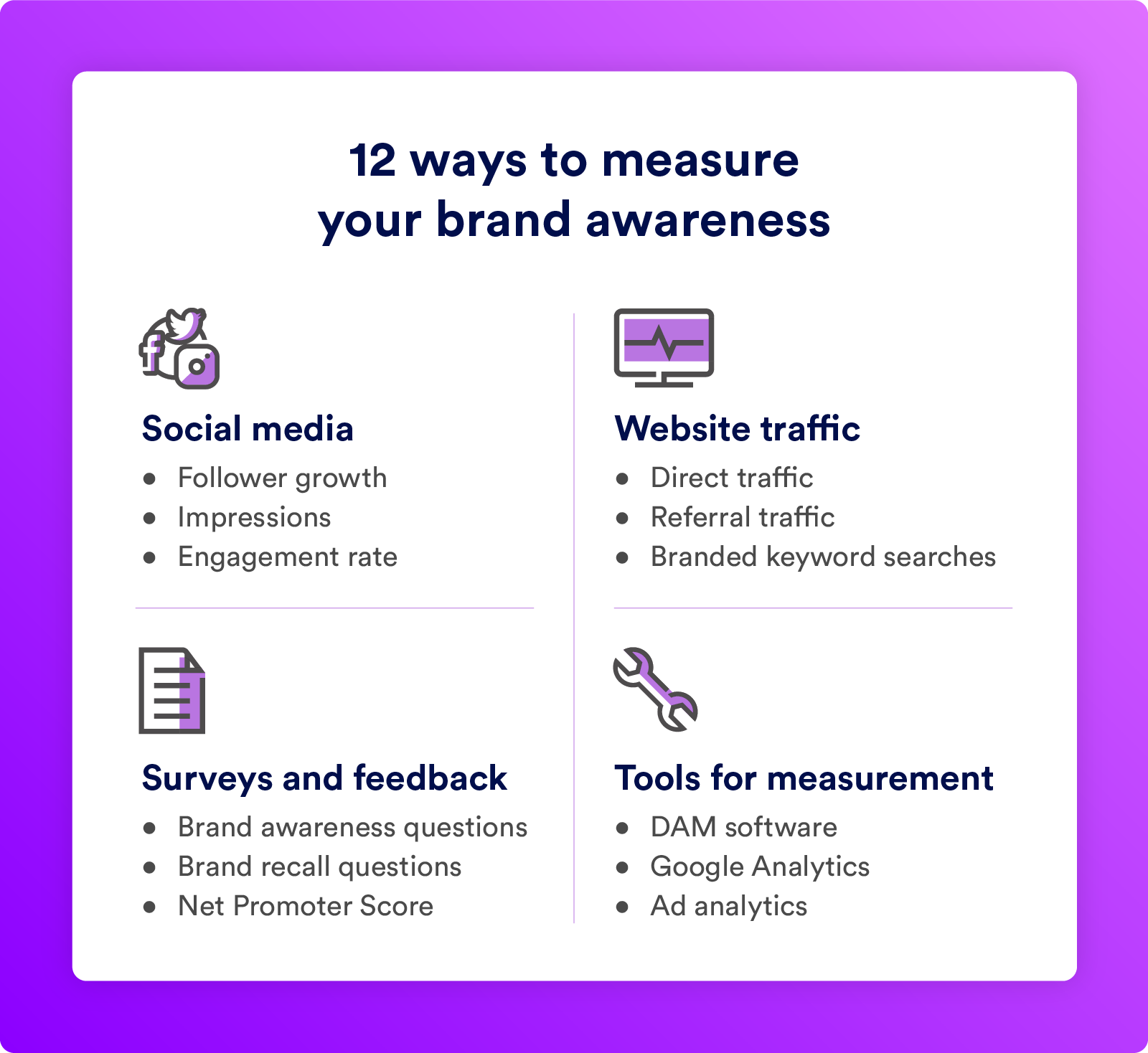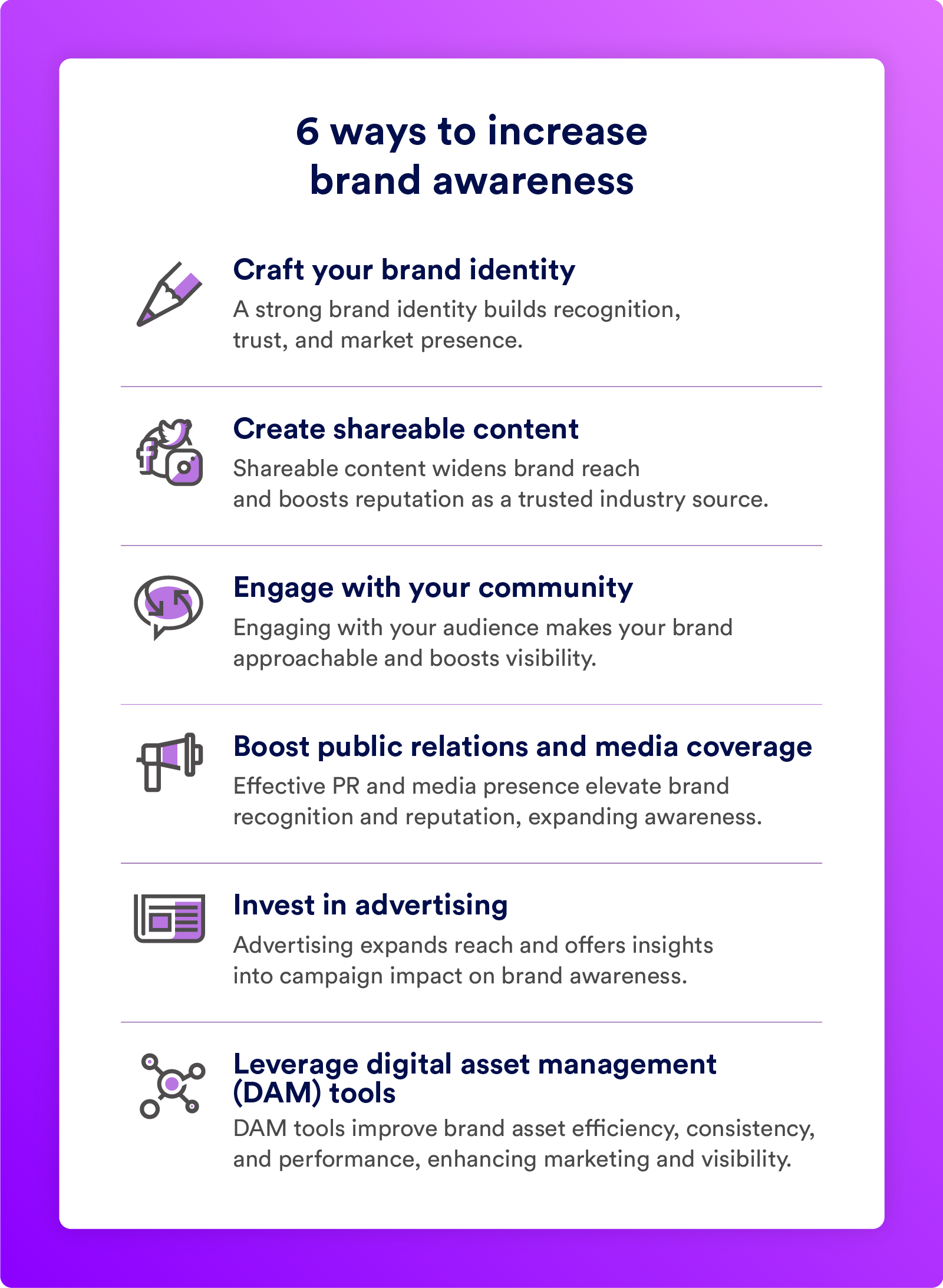Get branding tips and expert advice delivered straight to your inbox.
Today’s consumers have access to practically anything they want with the touch of a button — but along with the overwhelming number of options comes a lot of marketing noise.
This is where the power of brand awareness comes in, guiding consumers through the tumultuous sea of choices. It’s the reason you reach for a particular soda brand or immediately recognize a tech giant’s logo. It's the intangible force that compels us to trust, engage with, and advocate for a brand.
In this post, we’ll explore what brand awareness is, how to measure and increase brand awareness, and ways to monitor your brand awareness strategies. Whether you’re a seasoned marketer or you’re just embarking on your branding journey, this guide can help enhance your brand's recognition and resonance.
What Is Brand Awareness?
Brand awareness is the extent to which people are familiar with or recognize a brand. This means people can recall a brand’s name, logo, visual elements, and, more importantly, the feelings and perceptions associated with it. Brand awareness serves as a foundational element in a brand’s journey, as it creates a sense of recognition and trust among its audience.
Strong brand awareness is like a magnet, pulling in potential customers and making them more likely to choose your products or services over competitors. It establishes your brand’s credibility and positions it as a familiar, reliable choice in the market. Effective marketing campaigns aim to not only promote products or services but also create and reinforce brand awareness, helping the brand remain top of mind when the need for a product or service arises.
Types of Brand Awareness
Brand awareness can be split into three types: Brand recognition, brand recall, and brand dominance. Each type offers unique insights into how people perceive and engage with a brand.
Brand Recognition
Brand recognition refers to a person’s ability to recognize a brand when presented with visual or audio cues, such as its logo, slogan, or other brand elements, even if they are not actively seeking the brand.
Take McDonald’s, for example, with its iconic golden arches logo. The logo is so widely recognized that most people would be able to instantly identify it as McDonald’s without needing to read the brand name.
Brand Recall
Brand recall reflects a person’s ability to remember and name a brand when prompted with a product category or a specific need. So, if someone were asked to name soft drinks and their first answer was Coca-Cola, that would mean the company has a high brand recall.
Brand Dominance
Brand dominance occurs when a brand is so strongly associated with a particular product category that it becomes the primary choice for consumers, often without considering alternatives.
For example, many people might automatically think of Kleenex when they need facial tissues, to the extent that Kleenex has become synonymous with the product itself.

The Benefits of Strong Brand Awareness
Brand awareness can significantly impact a business’s success by fostering trust, attracting customers, and maintaining a competitive edge in the marketplace. There are many benefits of brand awareness, including:
- Competitive Advantage: Strong brand awareness sets you apart from competitors, making it easier to attract and retain customers in a competitive market.
- Increased Customer Trust and Loyalty: When consumers are familiar with your brand, they are more likely to trust it and choose it over competitors, often leading to long-term customer loyalty.
- Enhanced Marketing Efficiency: Since brand awareness increases familiarity, it’s easier to engage consumers with marketing for new products or promotions.
- Increased Sales: Recognizable brands tend to attract more customers, which can translate to increased sales and revenue.
- Ease of Expansion: Expanding into new markets or product lines is smoother when you have a well-known brand, as you already have a customer base and reputation that you can leverage.
How To Measure Brand Awareness
Measuring brand awareness is essential to understanding how well your target audience recognizes and perceives your brand. Here are twelve ways to measure brand awareness using social media reach and engagement, website traffic, surveys and feedback, and other measurement tools.
Social Media Reach and Engagement
Social media is more than just a platform for sharing vacation photos and reconnecting with old friends — it serves as a dynamic space where people and brands can ignite discussions and interact.
Globally, people allocate around 38 percent of their daily online activity to social media, so it presents an ideal place for connecting with both existing and prospective customers. By reviewing performance metrics and engaging in social listening, you can transform these observations into actionable insights. Here are several metrics for gauging your brand’s awareness on social media:
- Follower Growth: Monitor the increase in your social media followers over time. A growing follower base indicates a broader brand reach.
- Impressions: Track the number of times your social media posts are displayed to users. More impressions suggest increased brand exposure.
- Engagement Rate: Analyze likes, shares, comments, and click-through rates on your social media content. A higher engagement rate indicates more heightened brand awareness in your audience.
Website Traffic
Website traffic serves as an important measurement of brand awareness because it reflects how many people are actively seeking out or engaging with your brand online. For example, an increase in branded keyword searches after you drop a new marketing campaign suggests that consumers are becoming increasingly aware of your brand, indicating that your marketing campaign was successful.
Analyzing website traffic patterns can give you valuable insights into how sought-after and recognized your brand is, making it an essential metric for measuring brand awareness in the digital landscape. Here are a few metrics you can use to help you measure brand awareness through website traffic:
- Direct Traffic: Measure the number of visitors who directly type your website URL into their browsers. This can signify strong brand recall.
- Referral Traffic: Analyze traffic from other websites or platforms mentioning or linking to your brand. Referral traffic indicates external brand recognition.
- Branded Keyword Searches: Use tools like Google Analytics to track keyword searches for your brand name. An increase in these searches signifies higher brand awareness.
Surveys and Feedback
Surveys are great tools for measuring brand awareness because they directly capture your target audience’s perceptions and recognition level. By posing questions about your brand or asking participants to name brands within a particular category, you can gauge unaided brand recall.
These insights provide a clear picture of how well your audience knows and can recall your brand — and this picture can help you fine-tune your brand awareness strategies and strengthen your brand’s position. Here are a few ways you can gather insights on your brand awareness through surveys and feedback:
- Brand Awareness Questions: Conduct surveys among your target audience to assess their recognition and knowledge of your brand. Include questions like, “Have you heard of our brand?” or “Are you familiar with any of the following brands? Please select all that apply.”
- Brand Recall Questions: Ask survey respondents to name brands within specific product categories to gauge unaided brand recall. Some examples include, “Can you name any brands that offer (product/service)?” or “Which brand comes to mind when you think of (industry)?”
- Net Promoter Score (NPS): Assess customer loyalty and advocacy, as higher NPS scores often correlate with stronger brand awareness.
Tools for Measurement
Measurement tools play a crucial role in quantifying brand awareness as they provide organized and data-backed insights into your brand's presence and reputation. You have a range of tools at your fingertips, including Google Analytics, ad and social media analytics, and even DAM solutions like Brandfolder by Smartsheet.
For instance, Brand Intelligence provides insights into your assets, answering questions about how much, where, and by whom they are used. This data-driven approach enables a smarter and more effective brand strategy.
These tools enable you to efficiently assess the outcomes of your brand awareness initiatives, pinpoint areas that need refinement, and adjust your strategies accordingly.

How to Increase Brand Awareness
Increasing brand awareness requires a multifaceted approach. Here are some top strategies to help your business boost brand awareness.
Craft Your Brand Identity
Crafting your brand identity is the foundation of building brand awareness. Think about your brand’s unique value proposition, mission, and core values. Defining these brand pillars will guide your brand's personality and positioning.
Next, create a memorable logo, tagline, and visual identity — these will authentically convey your brand's essence and resonate with your target audience. Consistency is key, so make sure your branding remains uniform across all touchpoints, whether it’s your website, social media profiles, or marketing materials.
A cohesive brand identity not only fosters recognition but also communicates a sense of trust and reliability to your audience, ultimately strengthening your brand’s presence in the market.
Create Shareable Content
Creating shareable content is a great brand communication strategy that can help your brand gain more traction on the internet, ultimately increasing your brand awareness. You’ll need to develop high-quality, relevant content that genuinely connects with your target audience’s interests and needs.
The type of content that resonates most effectively can vary based on factors like your target audience, chosen platform, and brand identity. However, video marketing stands out as a highly engaging and widely shareable format. Studies found that 91 percent of consumers want more video content from brands online.
Shareable content not only expands your brand’s reach as it circulates through social networks, but also boosts your brand’s reputation as a trusted source of valuable information and entertainment within your industry or niche.
Engage With Your Community
Many consumers want to feel more connected with brands, and engaging with them is a great way to make that happen. High engagement establishes your brand as an approachable company, increasing your visibility with your target audience.
For example, if you run a travel brand, think about hosting an Instagram contest where you ask your followers to like a post, share it on their story, and tag a friend for a chance to win a free weekend getaway. It's a fun way to spread the word and increase brand awareness.
Additionally, it’s essential to quickly respond to comments, messages, brand mentions, and reviews across social media and review platforms. Remaining actively involved on these channels demonstrates your dedication to nurturing positive connections with your audience.
Boost Public Relations and Media Coverage
A well-executed PR strategy and media presence can significantly elevate your brand’s recognition and reputation, making it a powerful tool for expanding your brand awareness.
It involves actively building relationships with media outlets, influencers, and industry stakeholders to increase your brand’s visibility in the public eye. By effectively telling your brand’s story and sharing valuable insights or news, you establish credibility and trust. Media coverage in reputable outlets reinforces your brand’s authority and expands its reach to a broader audience.
You can also consider brand partnerships with influencers in your industry to create user-generated content and gather testimonials. With 50 percent of millennials trusting product recommendations from influencers, these real-life stories expand your brand’s reach and also build trust with potential customers.
Invest in Advertising
Advertising — whether you use Google, Facebook, YouTube, or another platform — is a great tool for increasing your brand awareness. While advertising typically comes at an upfront cost, it can help you expand your reach and gain insight into your campaigns’ impact on brand awareness.
With paid ads, you’ll also have the ability to target specific demographics, interests, and behaviors, ensuring they reach people who are likely to be invested in your products or services.
Leverage Digital Asset Management Tools
Leveraging digital asset management (DAM) tools enhances the efficiency, consistency, and performance of brand assets, ultimately leading to more effective and coordinated marketing efforts. By maintaining a strong brand presence across various channels and responding promptly to market demands, a brand can increase its visibility and awareness among its target audience.

Brand Awareness Mistakes To Avoid
In pursuing brand awareness, it's important to navigate the landscape carefully, avoiding common pitfalls that can hinder your progress. Here are some common mistakes to avoid when building your brand awareness.
Inconsistency in Branding
Maintaining brand consistency plays a pivotal role in reinforcing brand recognition and fostering trust among your audience. Nevertheless, in the dynamic world of marketing and creative collaboration, it can be quite challenging.
For instance, our State of Digital Asset Management report revealed that a significant 60 percent of participants continue to use incorrect versions of their company logo. This inconsistency can blur your brand’s distinct identity, so it’s important to ensure that your entire team is equipped with the right branding assets to keep your image sharp and unmistakable.
Neglecting Online Reputation Management
Neglecting online reputation management can be a significant mistake when it comes to building brand awareness. In today’s digital age, consumers often turn to online sources, including reviews and social media, to form opinions about brands. Negative comments or reviews, or misleading information, can spread quickly and damage your brand’s image.
For instance, a restaurant with a few negative reviews on popular review platforms may deter potential customers, even if the majority of customer experiences are positive. Proactive online reputation management involves monitoring online conversations, addressing negative feedback promptly, and promoting positive interactions. This ensures your brand’s online reputation remains favorable and trustworthy, and increases credibility and positive brand awareness.
Ignoring Social Media Engagement
Social media platforms are vibrant hubs where consumers actively engage with brands and their content. By ignoring social media engagement, you miss out on valuable opportunities to connect authentically with your audience, build relationships, and showcase your brand’s personality.
For instance, brands like Wendy’s have gained attention and increased brand awareness by engaging humorously with their followers on X (formerly Twitter). These interactions not only foster a positive brand image but also encourage users to share the brand’s content, extending its reach and influence. In today’s digital landscape, active social media engagement is key to elevating brand awareness and staying relevant to your target audience.
Focusing Solely on Sales Promotion
While sales promotions can drive short-term revenue spikes, they often lack the depth required to establish a lasting brand presence. Brand awareness is a long-term strategy that involves cultivating recognition, trust, and loyalty among consumers over time.
For instance, Apple’s brand awareness is rooted in its innovative technology and design, not just discounts or promotions. Relying solely on sales promotion can undermine your brand’s perceived value and longevity, potentially alienating customers who seek a more profound connection with your brand. Balancing sales promotion with broader brand-building efforts is crucial for achieving sustained brand awareness and continued success in the marketplace.
Monitoring Your Brand Awareness Strategy
Creating a brand awareness strategy is just the beginning; the key to long-term success lies in continuously monitoring and fine-tuning your efforts. Here are essential components of monitoring your brand awareness strategy.
Continuous Analysis and Reporting
To gauge the effectiveness of your brand awareness efforts, regularly collect and analyze relevant data and metrics. Track key performance indicators (KPIs) such as website traffic, social media engagement, brand mentions, and sentiment analysis. Comprehensive reporting allows you to measure your strategy’s impact and identify areas for improvement.
Adapting to Market Trends
Consumer behavior and the digital landscape are constantly evolving. Be aware of emerging market trends, technological advancements, and shifts in consumer preferences. Flexibility and adaptability are crucial to ensuring your brand awareness strategy remains relevant and effective.
Reassessing and Refining Your Brand Identity
Brand identity isn’t static; it can evolve with time. Periodically revisit your brand’s unique value proposition, mission, and core values. Assess whether they align with your target audience’s evolving needs and expectations. If necessary, refine your brand identity to maintain resonance with your audience.
Competitive Analysis
Keep an eye on your competitors and their brand awareness efforts. Analyze what strategies are working for them and identify gaps or opportunities you can leverage. Understanding your competitive landscape can help you stay ahead in the race for brand recognition.
Customer Feedback
Actively seek and listen to customer feedback. Customers’ insights and opinions can provide valuable information about how your brand is perceived and where improvements may be needed. Online surveys, reviews, and social media interactions are excellent channels for gathering customer input.
Manage Your Brand With Brandfolder
In the ever-evolving landscape of brand awareness, monitoring is the linchpin that allows you to adapt, refine, and optimize your strategy over time. By staying agile and data-driven, you can ensure your brand remains visible and relevant to your target audience.
If you’re searching for a tool to assist you in managing your brand and enhancing your brand awareness strategy, Brandfolder could be your solution. Our DAM software allows you to centralize and streamline all your brand assets, ensuring consistent and trustworthy branding. Our collaborative features extend your brand’s reach and responsiveness. At the same time, analytics facilitate data-driven enhancements to your strategy for building and monitoring brand awareness, ultimately fortifying your brand’s presence and resonance.
Reach out to our team and discover how Brandfolder can help you manage and improve your brand today.
